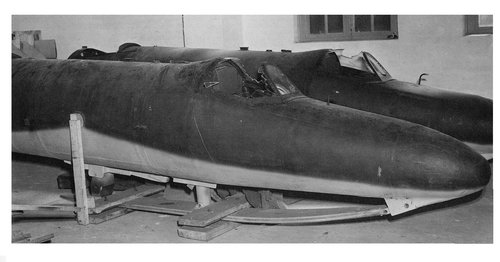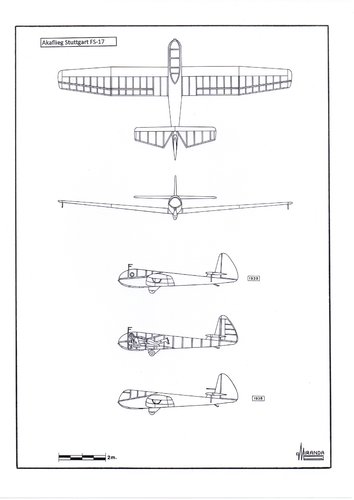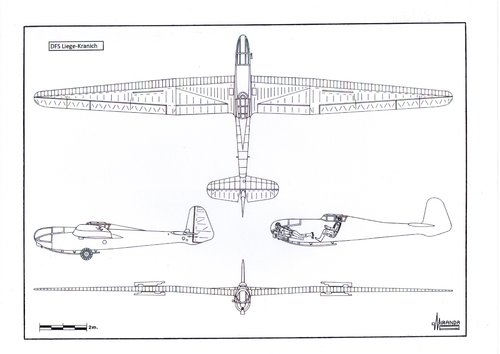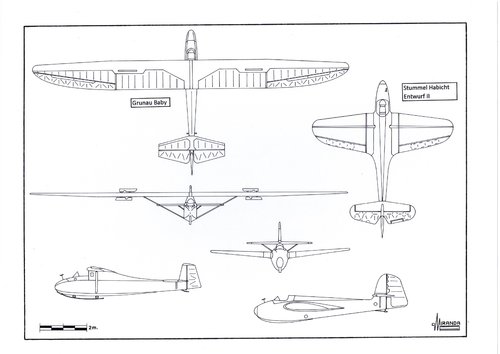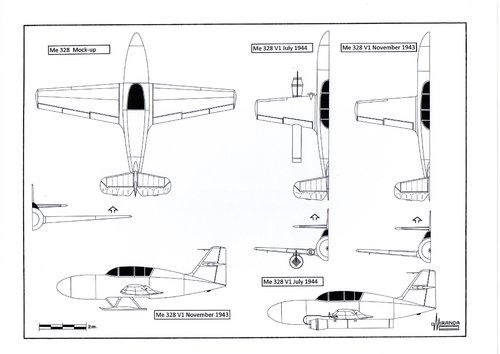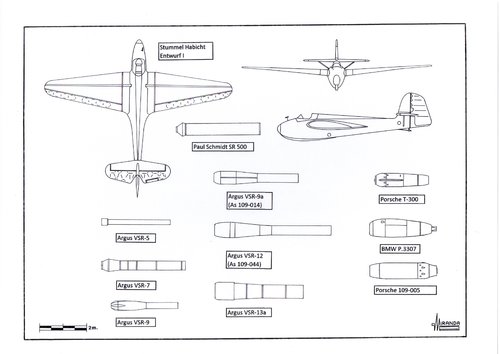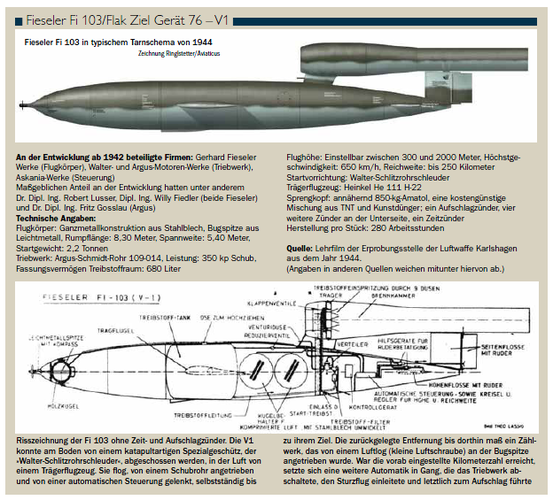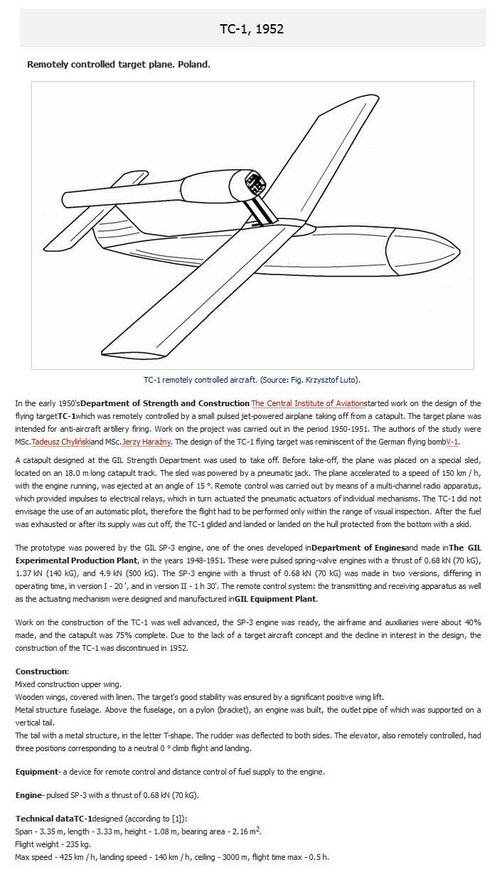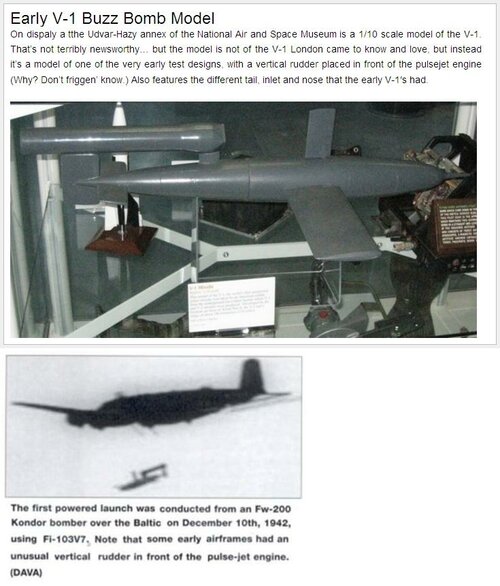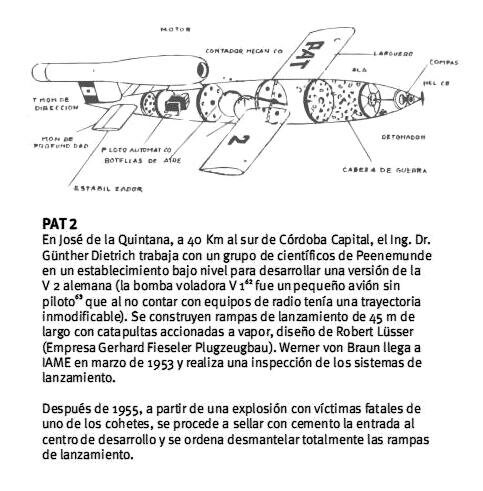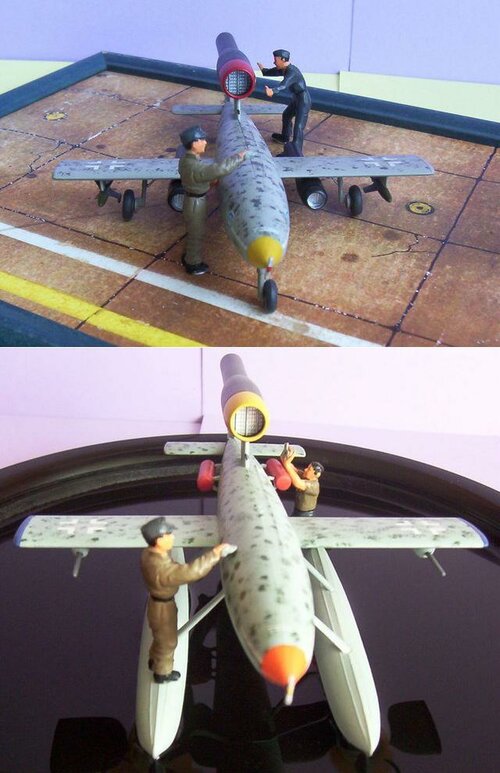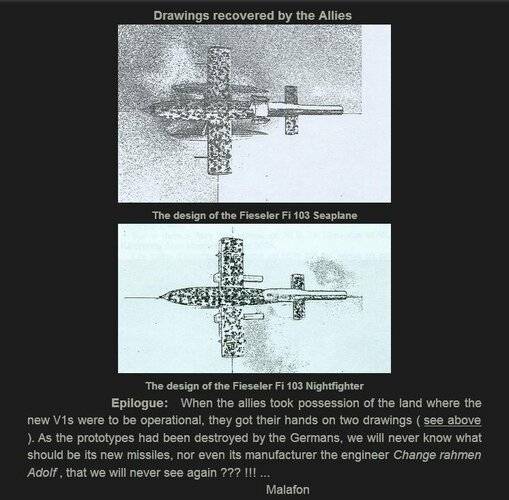PhotoDilandu, funding comes down from the top, not bcause the engineers wants to avoid the eastern front !
My point is - logic suggests that glider training was probably tried but soon abandoned in favour of the powered two seater.
However what I am really interested in, is hard facts - are there any photos or original drawings of the glider variants ? if not all the drawings are pure guesswork.
Hubert Chances drawing of the two seat glider states it was seen at Peenemunde and his drawing of the colour scheme suggests a photo - but has anyone seen such a photo ?
Paul
You are using an out of date browser. It may not display this or other websites correctly.
You should upgrade or use an alternative browser.
You should upgrade or use an alternative browser.
Fieseler Fi-103 (V 1) development, variants and derivatives
- Thread starter RyanC
- Start date
Dilandu
I'm dissatisfied, which means, I exist.
Some additional info and speculative stuff - 3
Very interesting!
Dilandu
I'm dissatisfied, which means, I exist.
P.S. I tried once to speculate about a possibility of Germany using V-1 missiles, launched from U-boat, to attack New York and Boston in early 1945:
https://warhead.su/2020/04/14/podvo...iego-reyha-mogli-li-nemtsy-udarit-po-nyuyorku
(on Russian, article in Russian "Warhead" magazine)

Came to interesting conclusion, that it was actually possible; the last few u-boats sunk near US coastline, actually came close enough to New York to put the city into range of Fi-103F-1 long-range missile. Of course, surfacing for launch would be insanely dangerous, but not impossible either.
The major problems would be non-catapult launch (for some reason, Germans didn't even consider rocket-boosted launch for Fi-103 - probably because of abysmal quality of German solid-fuel boosters), and correct aiming the missile. Since the submarine is not stable enough, and it's impossible to set the magnetic compass on Fi-103 by usual means, the only idea that I came with, was to install the FuG 230 Strasbourg radio control receiver onboard the missile, and connect it to the relay, controlling the heading gyro - to correctly aim missile while in flight.
Since the only possible time for u-boat near US coast in 1945 to surface and NOT be immediately destroyed was night, the radio-control system would also require some kind of radar tracking. I think, that standard u-boat FuMO 61 Hohentwiel radar, complemented by modified FuG 23 beacon onboard the missile could be used to track the missile for 20-30 km of its flight - enough to aim its heading more or less correctly.
The conclusion was, that it was actually possible - but military useless action. Just the projected losses of submarines would cost Germany order of magnitude more, than several widely inaccurate Fi-103 missiles hitting New York could inflict to Americans.
https://warhead.su/2020/04/14/podvo...iego-reyha-mogli-li-nemtsy-udarit-po-nyuyorku
(on Russian, article in Russian "Warhead" magazine)
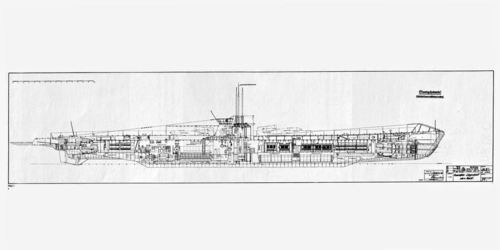
Came to interesting conclusion, that it was actually possible; the last few u-boats sunk near US coastline, actually came close enough to New York to put the city into range of Fi-103F-1 long-range missile. Of course, surfacing for launch would be insanely dangerous, but not impossible either.
The major problems would be non-catapult launch (for some reason, Germans didn't even consider rocket-boosted launch for Fi-103 - probably because of abysmal quality of German solid-fuel boosters), and correct aiming the missile. Since the submarine is not stable enough, and it's impossible to set the magnetic compass on Fi-103 by usual means, the only idea that I came with, was to install the FuG 230 Strasbourg radio control receiver onboard the missile, and connect it to the relay, controlling the heading gyro - to correctly aim missile while in flight.
Since the only possible time for u-boat near US coast in 1945 to surface and NOT be immediately destroyed was night, the radio-control system would also require some kind of radar tracking. I think, that standard u-boat FuMO 61 Hohentwiel radar, complemented by modified FuG 23 beacon onboard the missile could be used to track the missile for 20-30 km of its flight - enough to aim its heading more or less correctly.
The conclusion was, that it was actually possible - but military useless action. Just the projected losses of submarines would cost Germany order of magnitude more, than several widely inaccurate Fi-103 missiles hitting New York could inflict to Americans.
P.S. I tried once to speculate about a possibility of Germany using V-1 missiles, launched from U-boat, to attack New York and Boston in early 1945:
https://warhead.su/2020/04/14/podvo...iego-reyha-mogli-li-nemtsy-udarit-po-nyuyorku
(on Russian, article in Russian "Warhead" magazine)
View attachment 632608
Came to interesting conclusion, that it was actually possible; the last few u-boats sunk near US coastline, actually came close enough to New York to put the city into range of Fi-103F-1 long-range missile. Of course, surfacing for launch would be insanely dangerous, but not impossible either.
The major problems would be non-catapult launch (for some reason, Germans didn't even consider rocket-boosted launch for Fi-103 - probably because of abysmal quality of German solid-fuel boosters), and correct aiming the missile. Since the submarine is not stable enough, and it's impossible to set the magnetic compass on Fi-103 by usual means, the only idea that I came with, was to install the FuG 230 Strasbourg radio control receiver onboard the missile, and connect it to the relay, controlling the heading gyro - to correctly aim missile while in flight.
Since the only possible time for u-boat near US coast in 1945 to surface and NOT be immediately destroyed was night, the radio-control system would also require some kind of radar tracking. I think, that standard u-boat FuMO 61 Hohentwiel radar, complemented by modified FuG 23 beacon onboard the missile could be used to track the missile for 20-30 km of its flight - enough to aim its heading more or less correctly.
The conclusion was, that it was actually possible - but military useless action. Just the projected losses of submarines would cost Germany order of magnitude more, than several widely inaccurate Fi-103 missiles hitting New York could inflict to Americans.
The accuracy of the Reichenberg allowed the Luftwaffe to destroy, for the first time in the war, with security and economy of means all kinds of high valuable targets like warships, aircraft factories, military HQ, munitions depots, bridges and power stations.
It was also considered its use for political purposes, based on the idea that an attack carried out against the Buckingham Palace, the Houses of Parliament or the White House could create the right situation for some kind of peace agreement. For the attack on Washington, it was proposed to arm some U-boat Type XXI with a Reichenberg IV housed in a watertight container located on the rear deck behind the conning tower. The problem with Type XXI is that they were not big enough to use the same system of steam catapults installed on Japanese submarines of the Sen-Toku series. Nor was it possible to use the catapult 'Madelung KL 12', designed for launching unmanned missiles because its length was 42 m and its terminal speed of 105 mps would make the pilot lose consciousness.
The solution proposed by the Dipl. Ing. Willy Fiedler consisted of a folding ramp, only 10 m. length, which was originally designed to launch the Natter. With the use of two RATO rockets of the Schmidding 109-533 type a softer thrust would be obtained until reaching the starting speed of the pulsejet. After the war, Willy Fiedler worked designing several U.S. Navy submarine launch systems for the 'Loon' and 'Regulus' missiles.
Dilandu
I'm dissatisfied, which means, I exist.
The accuracy of the Reichenberg allowed the Luftwaffe to destroy, for the first time in the war, with security and economy of means all kinds of high valuable targets like warships, aircraft factories, military HQ, munitions depots, bridges and power stations.
Well, frankly, I do not believe that piloted version would actually work better than pilot-less. Anyway, the Reichenberg project was essentially on hold since October 1944, and just training the pilots to fly this jury-rigged contraption would probably took far too long.
- In early 1945 the Allies electronic technology was so advanced that they could interfere any radio-controlled system built by the Germans. The Axis only possibility was using suicide pilots. After the failure of the Messerschmitt Me 328, Hanna Reitsch, who had participated in its testing program piloting one of the prototypes and was greatly affected by the bombing of German cities, met with Otto Skorzeny to support his idea of using a piloted version of the V-1. The successes achieved by the kamikazes in the Far East strengthened the position of those in favour of creating S.O. units and the OKL finally authorized the transformation of several V-1 missiles into piloted flights, under the codename Reichenberg.
The work was undertaken by DFS-Ainring with the installation of a cockpit, instruments and flying controls in the space formerly occupied by the two spherical air bottles. Ailerons also were fitted in the wing trailing edges and the surface of the rudder doubled to improve manoeuvrability. In the prototype, the fuel tank and the warhead were replaced by sand bags of equivalent weight.
The first aircraft was transformed in just fourteen days, initiating flight tests Lärz, slung under the port wing of a Heinkel 111. After launch, the pilot lost control and the Reichenberg turned was destroyed. The same happened with the second prototype when attempting a landing without flaps at more than 220 kph. The system of sand ballast was replaced by a water tank that could be emptied in flight to lighten the plane before landing, although sometimes the discharge valve froze, as it happened to Hanna Reitsch with the third prototype during a launch from 18,000 ft. After making a successful flight test on the pulsejet in the Karlshagen Erprobungsstelle, it was decided that the Reichenberg would enter mass production.
With a speed of 800 kph maximum dive and a cockpit design that prevented the installation of an ejector seat, no one doubted that it was a suicide project. But the OKL insisted that S.O. pilots were trained in landing manoeuvres, for the sake of formality. DFS build three versions of training: a two seat unpowered glider based on the airframe of a Fi 103 A called Reichenberg I, a pulsejet powered two seat called Reichenberg II and a pulsejet powered single seat called Reichenberg III for advanced training. All these variants were equipped with a landing skid and were reusable.
The S.O. version, named Reichenberg IV, was based on the airframe of the Fieseler Fi 103 B-1, with wooden wings, Amatol 39 A warhead and three impact fuses. The launch system was dangerous and ineffective, the Heinkel should take off with a large asymmetric load of 2,250 kg which would mean the loss of both aircraft in the event of failure of the port engine. The S.O. pilot remained aboard the Reichenberg since before docking under the Heinkel and the cockpit could not be opened until after launch because of the relative position of both planes.
The 5./KG200 was the Luftwaffe unit responsible for the formation of a first batch of 70 S.O. pilots. The Training Programme included a number of flights in elemental gliders of the Grunau Baby type, then started to use the Stummel Habicht - a single seat version of the aerobatic glider DFS Habicht - with reinforced airframe and wingspan reduced from 13.6 to 6 m. The Stummel of short wings could fly at 300 kph in diving, but it was dangerous at landing because of its stalling speed of 80 kph. At the next level of training, the pilots got familiar with the flight controls of the Reichenberg I, performing various take-off towed aloft by a Henschel Hs 126. The ignition of the pulsejet was practiced with the Reichenberg II two seat trainer, making a shallow dive to reach the ignition speed of 400 kph.
In the final stage, the pilots performed a flight in the single seat version of the Reichenberg III which included the simulation of a terminal dive to become familiar with the tightening of the flight controls at high speeds.
In November 1944 there was no point in trying to destroy the allied invasion fleets and the naval versions of the Reichenberg IV were left aside to enhance the strategic bombing versions. It was suggested that one S.O. variant of the Fieseler Fi 103 B-1 would be carried under a Heinkel He 177 to attack the Soviet industrial centres of Kuibyschew, Tscheljabinski and Magnitogorsk.
On February 24, 1945, only 34 S.O. pilots had completed training due to fuel shortages. The Reichenberg IV Programme was cancelled on March 15 without being used operationally because the Luftwaffe preferred to use the Mistel for their last bombing missions. At the end of the war in Europe, the Allies discovered about 500 airframes of Reichenberg IV in different stages of construction in the Pulverhoff VI assembly plant of Dannenberg. At least 175 of them were ready for combat.
The Reichenberg V was the project of a single seat trainer, based on the Reichenberg III to be used by the pilots of the new generation of fighters and fighter-bombers powered by pulsejets (Heinkel He 162 A-10 and A-11, Heinkel P.1077 Romeo and Junkers EF 126) with which the OKL hoped to continue the fight in 1945.
The work was undertaken by DFS-Ainring with the installation of a cockpit, instruments and flying controls in the space formerly occupied by the two spherical air bottles. Ailerons also were fitted in the wing trailing edges and the surface of the rudder doubled to improve manoeuvrability. In the prototype, the fuel tank and the warhead were replaced by sand bags of equivalent weight.
The first aircraft was transformed in just fourteen days, initiating flight tests Lärz, slung under the port wing of a Heinkel 111. After launch, the pilot lost control and the Reichenberg turned was destroyed. The same happened with the second prototype when attempting a landing without flaps at more than 220 kph. The system of sand ballast was replaced by a water tank that could be emptied in flight to lighten the plane before landing, although sometimes the discharge valve froze, as it happened to Hanna Reitsch with the third prototype during a launch from 18,000 ft. After making a successful flight test on the pulsejet in the Karlshagen Erprobungsstelle, it was decided that the Reichenberg would enter mass production.
With a speed of 800 kph maximum dive and a cockpit design that prevented the installation of an ejector seat, no one doubted that it was a suicide project. But the OKL insisted that S.O. pilots were trained in landing manoeuvres, for the sake of formality. DFS build three versions of training: a two seat unpowered glider based on the airframe of a Fi 103 A called Reichenberg I, a pulsejet powered two seat called Reichenberg II and a pulsejet powered single seat called Reichenberg III for advanced training. All these variants were equipped with a landing skid and were reusable.
The S.O. version, named Reichenberg IV, was based on the airframe of the Fieseler Fi 103 B-1, with wooden wings, Amatol 39 A warhead and three impact fuses. The launch system was dangerous and ineffective, the Heinkel should take off with a large asymmetric load of 2,250 kg which would mean the loss of both aircraft in the event of failure of the port engine. The S.O. pilot remained aboard the Reichenberg since before docking under the Heinkel and the cockpit could not be opened until after launch because of the relative position of both planes.
The 5./KG200 was the Luftwaffe unit responsible for the formation of a first batch of 70 S.O. pilots. The Training Programme included a number of flights in elemental gliders of the Grunau Baby type, then started to use the Stummel Habicht - a single seat version of the aerobatic glider DFS Habicht - with reinforced airframe and wingspan reduced from 13.6 to 6 m. The Stummel of short wings could fly at 300 kph in diving, but it was dangerous at landing because of its stalling speed of 80 kph. At the next level of training, the pilots got familiar with the flight controls of the Reichenberg I, performing various take-off towed aloft by a Henschel Hs 126. The ignition of the pulsejet was practiced with the Reichenberg II two seat trainer, making a shallow dive to reach the ignition speed of 400 kph.
In the final stage, the pilots performed a flight in the single seat version of the Reichenberg III which included the simulation of a terminal dive to become familiar with the tightening of the flight controls at high speeds.
In November 1944 there was no point in trying to destroy the allied invasion fleets and the naval versions of the Reichenberg IV were left aside to enhance the strategic bombing versions. It was suggested that one S.O. variant of the Fieseler Fi 103 B-1 would be carried under a Heinkel He 177 to attack the Soviet industrial centres of Kuibyschew, Tscheljabinski and Magnitogorsk.
On February 24, 1945, only 34 S.O. pilots had completed training due to fuel shortages. The Reichenberg IV Programme was cancelled on March 15 without being used operationally because the Luftwaffe preferred to use the Mistel for their last bombing missions. At the end of the war in Europe, the Allies discovered about 500 airframes of Reichenberg IV in different stages of construction in the Pulverhoff VI assembly plant of Dannenberg. At least 175 of them were ready for combat.
The Reichenberg V was the project of a single seat trainer, based on the Reichenberg III to be used by the pilots of the new generation of fighters and fighter-bombers powered by pulsejets (Heinkel He 162 A-10 and A-11, Heinkel P.1077 Romeo and Junkers EF 126) with which the OKL hoped to continue the fight in 1945.
Attachments
- Joined
- 26 May 2006
- Messages
- 34,895
- Reaction score
- 15,759
Many thanks to you my dear Justo,
and if we discussed this Project before here or not ?.
and if we discussed this Project before here or not ?.
Attachments
Do you remember about P2 submarine projects ? http://www.hisutton.com/Stalins Super Sub - Project P-2.html . Surely there were derivates of A-4 and Fieseler V-1 for the missiles .
Dilandu
I'm dissatisfied, which means, I exist.
Do you remember about P2 submarine projects ? http://www.hisutton.com/Stalins Super Sub - Project P-2.html . Surely there were derivates of A-4 and Fieseler V-1 for the missiles .
Yes, Chelomei X-series missiles:
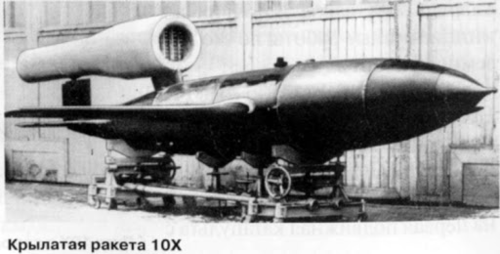
The 10X was generally a reverse-engineering of V-1. Not an exact copy, since we do not have any complete V-1 available. Autopilot's gyro was of Soviet design, for example, and fuel feeding system was more advanced, so 10X was a bit faster.
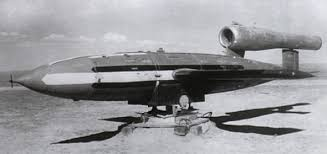
The 14X was post-war development, with more powerful engine, and much higher speed (about 872 km/h). Wasn't successful, because to compensate for the heavier engine, the wing structure was lightened, and was found to be unable to withstand high-speed conditions.
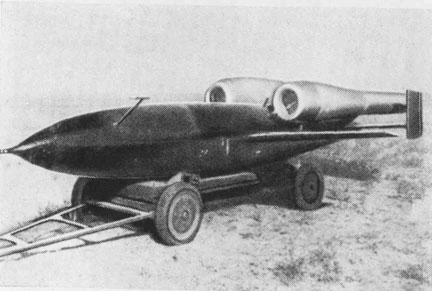
The 16X "Priboy" ("Tidal wave") was the final development of V-1 derivatives in USSR. It was powered by two pulsejets in V-comfiguration, and capable of 1000 km/h speed on 190 km range. It was supposed to be equipped by radio navigation system, to improve accuracy, but works never get this far; in 1953, it was decided that the pulsejet-powered flying bombs are just too limited, unreliable and have no further space to improvements.
P.S. The main carriers of those missiles were supposed to be bombers, the shipborne deployment was only secondary, and apparently no X-series missile was ever launched from a ship even for testing purposes (however, I may be mistaken here)
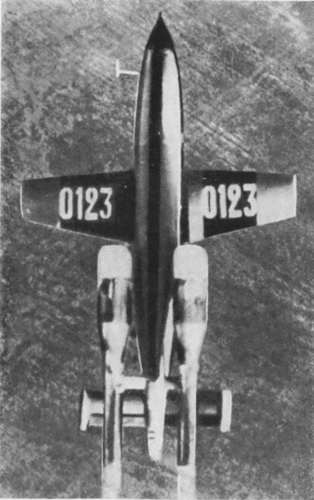
Yes , on Submarine P2 , was projected to carry from 14 to maximum 41 Chelomei 10X .Do you remember about P2 submarine projects ? http://www.hisutton.com/Stalins Super Sub - Project P-2.html . Surely there were derivates of A-4 and Fieseler V-1 for the missiles .
Yes, Chelomei X-series missiles:
View attachment 642792
The 10X was generally a reverse-engineering of V-1. Not an exact copy, since we do not have any complete V-1 available. Autopilot's gyro was of Soviet design, for example, and fuel feeding system was more advanced, so 10X was a bit faster.
View attachment 642793
The 14X was post-war development, with more powerful engine, and much higher speed (about 872 km/h). Wasn't successful, because to compensate for the heavier engine, the wing structure was lightened, and was found to be unable to withstand high-speed conditions.
View attachment 642795
The 16X "Priboy" ("Tidal wave") was the final development of V-1 derivatives in USSR. It was powered by two pulsejets in V-comfiguration, and capable of 1000 km/h speed on 190 km range. It was supposed to be equipped by radio navigation system, to improve accuracy, but works never get this far; in 1953, it was decided that the pulsejet-powered flying bombs are just too limited, unreliable and have no further space to improvements.
P.S. The main carriers of those missiles were supposed to be bombers, the shipborne deployment was only secondary, and apparently no X-series missile was ever launched from a ship even for testing purposes (however, I may be mistaken here)
View attachment 642794
Dilandu
I'm dissatisfied, which means, I exist.
Yes , on Submarine P2 , was projected to carry from 14 to maximum 41 Chelomei 10X .
To be exact, P-2 was purely a research effort; an attempt to investigate the possible ways of adapting missile technology to submarines. It was never intended to be build.
maxmwill
I really should change my personal text
- Joined
- 29 October 2011
- Messages
- 60
- Reaction score
- 21
Wasn't the Focke Wulf rammjaeger that is in your book based upon the Feiseler Fi-103?From Reichdreams Nº4
Some information (in Dutch) : http://users.telenet.be/denzjos/pulsejets/V1_pulsejets.html
- Joined
- 13 August 2007
- Messages
- 8,445
- Reaction score
- 10,999
P.S. I tried once to speculate about a possibility of Germany using V-1 missiles, launched from U-boat, to attack New York and Boston in early 1945:
interested Concept
The illustration has one flaw, how to get V1 out it's container and move at long Bridge Fin to catapult ?
install container in front of Bridge Fin
On now shorter Catapult, they could use solid rocket motor to accelerate V1 until Argus Puls engine works
Dilandu
I'm dissatisfied, which means, I exist.
Thank you)interested Concept
Yep, must admit, that I did not think about it when I draw that illustration) Only later I realized, that it would be problematic to move missile forward, but it was too late to remade the picture...The illustration has one flaw, how to get V1 out it's container and move at long Bridge Fin to catapult ?
install container in front of Bridge Fin
Yep, it would probably be more logical.
Dilandu
I'm dissatisfied, which means, I exist.
For some reason, Germans didn't like that idea. Despite obvious shortcoming of catapult launch, they did not even attempt to create simpler booster launchers. I suspect, that the quality of their solid rocket booster was inadequate, and they could not be relied on.On now shorter Catapult, they could use solid rocket motor to accelerate V1 until Argus Puls engine works
- Joined
- 13 August 2007
- Messages
- 8,445
- Reaction score
- 10,999
yes, is a strange caseFor some reason, Germans didn't like that idea.
One reason they consider the V1 not as a effective weapon, more as Terror weapon
The Kriegsmarine on other hand defy any attempt to put aircraft
And so far i know NSDAP had issue with solid rocket because of Rudolf Nebel, the leading scientist on Solid rocket motor.
1934 in connection with the Röhm putsch, he was arrested and considered as politically unreliable.
Nebel was excluded from any missile development for life.
yes, they worked on Solids motors during WW2, but not supported by high rank Nazi and on low priority programs...
Last edited:
Grzesio
ACCESS: Secret
They did. A Rheinmetall rocket propelled launcher was tested in Peenemuende already duringDespite obvious shortcoming of catapult launch, they did not even attempt to create simpler booster launchers.
early stages of V-1 development. But, as far as I remember, it was of similar size as the steam catapult then.
Kriegsmarine placed an order at Rheinmetall in mid 1944 for development of a long range rocket launcher for submarines, plus a variant of the Rheinbote with some 120 kg warhead and 100 km range.The Kriegsmarine on other hand defy any attempt to put aircraft or rocket on there Subs
Last edited:
Adoption of the Walter peroxide catapult had nothing to do with politics or personalities but was because of problems with the Borsig solid propellant launcher: see http://cartalana.com/017-01.phpyes, is a strange caseFor some reason, Germans didn't like that idea.
One reason they consider the V1 not as a effective weapon, more as Terror weapon
The Kriegsmarine on other hand defy any attempt to put aircraftor rocketon there Subs
And so far i know NSDAP had issue with solid rocket because of Rudolf Nebel, the leading scientist on Solid rocket motor.
1934 in connection with the Röhm putsch, he was arrested and considered as politically unreliable.
Nebel was excluded from any missile development for life.
yes, they worked on Solids motors during WW2, but not supported by high rank Nazi and on low priority programs...
T. A. Gardner
ACCESS: Top Secret
- Joined
- 18 February 2021
- Messages
- 1,152
- Reaction score
- 2,022
In all this, it is interesting that the Germans didn't propose any sort of electronic homing like radar, or an anti-radar homing missile out of the V-1. I suppose that's in part due to it being a Luftwaffe weapon system intended for area attack of cities. I think a V-1 antiship missile would have had real possibility as a serious weapon system. All you'd need is a decent radar homing system and it could have been used primarily on merchant ships versus warships.
But as far as I know, the Germans didn't produce any ASM's using such a system like the US Pelican, Bat, or Gargoyle glide bombs / missiles. Probably a good thing for Allied naval forces...
But as far as I know, the Germans didn't produce any ASM's using such a system like the US Pelican, Bat, or Gargoyle glide bombs / missiles. Probably a good thing for Allied naval forces...
Dilandu
I'm dissatisfied, which means, I exist.
In all this, it is interesting that the Germans didn't propose any sort of electronic homing like radar, or an anti-radar homing missile out of the V-1. I suppose that's in part due to it being a Luftwaffe weapon system intended for area attack of cities.
As far as I know, after "battle of the beams", Germans lost any confidence in their radio navigation system. They thought, that such system would be very quickly jammed, thus rendering V-1 useless - and considering rather abysmal quality of German electronics, it wasn't exactly the completely unfounded proposition.
I think a V-1 antiship missile would have had real possibility as a serious weapon system. All you'd need is a decent radar homing system and it could have been used primarily on merchant ships versus warships.
It would require installing some kind of autonomous radar homing system - which were problematic even for US at this time (look at Bat performance, and Bat was dedicated, very advanced weapon, lightyear ahead of anything Germans could do).
Technically, it was possible to install crude radar seeker on V-1. By reducing warhead & fuel supply, enough weight could be saved for simple lobe-switching radar with antennas installed on wings. Comparing automatically the signal output from right & left / upper & lower lobes to hold the target directly on course would be within even German capabilities (though with Nazi usual techno-incompetense, they could screw up even this...)
But V-1 was poorly suited for anti-ship missile purpose. It does not have enough maneuvering capability. Its rudder & servo system was relatively crude, not suited for precise maneuvering required to hit a moving target. Also, there was no roll control at all, which would be... problematic for anti-ship missile.
Gargoyle glide bombs / missiles.
Well, Gargoyle was command-controlled, with visual tracking by operator. Hs.298 was a relatively close analogue.
ArmchairSamurai
ACCESS: Confidential
- Joined
- 1 July 2019
- Messages
- 183
- Reaction score
- 254
Out of curiosity, what about the Leitstrahlstellung radio beam? The Allies did not even know it existed until after the war.In all this, it is interesting that the Germans didn't propose any sort of electronic homing like radar, or an anti-radar homing missile out of the V-1. I suppose that's in part due to it being a Luftwaffe weapon system intended for area attack of cities.
As far as I know, after "battle of the beams", Germans lost any confidence in their radio navigation system. They thought, that such system would be very quickly jammed, thus rendering V-1 useless - and considering rather abysmal quality of German electronics, it wasn't exactly the completely unfounded proposition.
I think a V-1 antiship missile would have had real possibility as a serious weapon system. All you'd need is a decent radar homing system and it could have been used primarily on merchant ships versus warships.
It would require installing some kind of autonomous radar homing system - which were problematic even for US at this time (look at Bat performance, and Bat was dedicated, very advanced weapon, lightyear ahead of anything Germans could do).
Technically, it was possible to install crude radar seeker on V-1. By reducing warhead & fuel supply, enough weight could be saved for simple lobe-switching radar with antennas installed on wings. Comparing automatically the signal output from right & left / upper & lower lobes to hold the target directly on course would be within even German capabilities (though with Nazi usual techno-incompetense, they could screw up even this...)
But V-1 was poorly suited for anti-ship missile purpose. It does not have enough maneuvering capability. Its rudder & servo system was relatively crude, not suited for precise maneuvering required to hit a moving target. Also, there was no roll control at all, which would be... problematic for anti-ship missile.
Gargoyle glide bombs / missiles.
Well, Gargoyle was command-controlled, with visual tracking by operator. Hs.298 was a relatively close analogue.
http://www.v2rocket.com/start/deployment/leitstrahl.html
Dilandu
I'm dissatisfied, which means, I exist.
As far as I understood, it was a pretty trivial Lorentz beam system (i.e. two narrow beams with different signals encoded, intersecting in very thin central area):Out of curiosity, what about the Leitstrahlstellung radio beam? The Allies did not even know it existed until after the war.
Essentially it was never detected because it aimed a very narrow beam high in the sky, for the ballistic missile to correct its boost (since ballistic missile is guided only during boost phase).The development of the instruments was given to the navigations department of the firm "Lorenz". They delivered "Leitstrahl-(LS)-facheranlage Viktoria" appearing in Nov. of 1940 as a 500 watt adjusting transmitter for the UKW beaken. This transmitter had a frequency of 45 Mhz and was probably devoloped from a landing beaken. It was a "Phasedreiglieder" twice with a deflector contained a horizontal dipole antenna, that was set up at a distance of 8-15 km's behind the launchpad. One of the antennas was direct connected to the transmitter and the other was attached to a "drehkondensator" in a tastverhaltnis 1:1 and 30 times per minute changed in phase. You can see the opposing V2 rocket dipole attenna attached on later production V2 pictures, coming out of the trailing edge of the rocket fins. The plans for this bunker were drawn up in September of 1943.
Synchronous switching of the modulation tone was to take place between 5-7 kHz. Two fan-shaped signals, with different modulation tones, formed the beams of only 0.0125 degrees. These would overlap in places, resulting in an amplitude difference of the modulation of about 5%. The system had to be adjusted very exactly, since the strength of the main beam in relation to the inversly formed counter beam only amounted to 2 degrees.
Problem is, that for guidance of cruise missile - like V-1 - such beam must be lowered so the cruise missile could ride along it to the target. And since cruise altitude of V-1 was no more than 1000 meters - it was just plainly impossible to set the beam so that it would run no more than 1000 meters high over Britain. Curvature of Earth surface forbade that.
ArmchairSamurai
ACCESS: Confidential
- Joined
- 1 July 2019
- Messages
- 183
- Reaction score
- 254
Good point. I meant more the portable version that was postulated in the article I linked. I should have been more specific with what I meant. I suppose, and you can shoot this down for its sheer implausibility, but it can be suggested that such a portable version could be mounted ship-wise in a configuration similar to the setup of MS Togo; that being said, it is still a vulnerable target and an obvious one at that, so without proper protection, something the KMS could ill afford to spare, its rather pointless. Interesting to postulate, and that's it. Without actually knowing what the device would have looked like, size-wise, equipment-wise, and functionality-wise, it's a pipe dream.As far as I understood, it was a pretty trivial Lorentz beam system (i.e. two narrow beams with different signals encoded, intersecting in very thin central area):Out of curiosity, what about the Leitstrahlstellung radio beam? The Allies did not even know it existed until after the war.
Essentially it was never detected because it aimed a very narrow beam high in the sky, for the ballistic missile to correct its boost (since ballistic missile is guided only during boost phase).The development of the instruments was given to the navigations department of the firm "Lorenz". They delivered "Leitstrahl-(LS)-facheranlage Viktoria" appearing in Nov. of 1940 as a 500 watt adjusting transmitter for the UKW beaken. This transmitter had a frequency of 45 Mhz and was probably devoloped from a landing beaken. It was a "Phasedreiglieder" twice with a deflector contained a horizontal dipole antenna, that was set up at a distance of 8-15 km's behind the launchpad. One of the antennas was direct connected to the transmitter and the other was attached to a "drehkondensator" in a tastverhaltnis 1:1 and 30 times per minute changed in phase. You can see the opposing V2 rocket dipole attenna attached on later production V2 pictures, coming out of the trailing edge of the rocket fins. The plans for this bunker were drawn up in September of 1943.
Synchronous switching of the modulation tone was to take place between 5-7 kHz. Two fan-shaped signals, with different modulation tones, formed the beams of only 0.0125 degrees. These would overlap in places, resulting in an amplitude difference of the modulation of about 5%. The system had to be adjusted very exactly, since the strength of the main beam in relation to the inversly formed counter beam only amounted to 2 degrees.
Problem is, that for guidance of cruise missile - like V-1 - such beam must be lowered so the cruise missile could ride along it to the target. And since cruise altitude of V-1 was no more than 1000 meters - it was just plainly impossible to set the beam so that it would run no more than 1000 meters high over Britain. Curvature of Earth surface forbade that.
Dilandu
I'm dissatisfied, which means, I exist.
Well, technically it could, and it would work rather fine. V-1 was relatively easy to convert to radio guidance; she used electric relays to read course gyro, so all you need is to connect output cables from radio control receiver onboard. The main problem would be the distance-finding (when exactly to send a "drop" command to V-1) and possibility of British radio interference. After all, Lorentz guidance beams over Britain is exactly what Germans tried in 1940-1941 night attacks (Coventry raid), and Britain have planes with detectors constantly searching for them.
ArmchairSamurai
ACCESS: Confidential
- Joined
- 1 July 2019
- Messages
- 183
- Reaction score
- 254
Very true. I wonder if then a combination of Leitstrahlstellung and something akin to Klein Heidelberg could be used to counteract that.Well, technically it could, and it would work rather fine. V-1 was relatively easy to convert to radio guidance; she used electric relays to read course gyro, so all you need is to connect output cables from radio control receiver onboard. The main problem would be the distance-finding (when exactly to send a "drop" command to V-1) and possibility of British radio interference. After all, Lorentz guidance beams over Britain is exactly what Germans tried in 1940-1941 night attacks (Coventry raid), and Britain have planes with detectors constantly searching for them.
klem
I really should change my personal text
- Joined
- 7 March 2015
- Messages
- 726
- Reaction score
- 1,633
klem
I really should change my personal text
- Joined
- 7 March 2015
- Messages
- 726
- Reaction score
- 1,633
On a French Blog, I found an article about the history of the V1 with real pictures and this. I doubt it's true. The problem is that the blogger doesn't say it's a What if? Is it true?
https://maquettes-missiles.blogspot.com/p/lhistoire-du-fieseler-fi-103-fzg-76-ou.html
https://maquettes-missiles.blogspot.com/p/lhistoire-du-fieseler-fi-103-fzg-76-ou.html
Attachments
Dilandu
I'm dissatisfied, which means, I exist.
What exactly not seems to be true here?On a French Blog, I found an article about the history of the V1 with real pictures and this. I doubt it's true. The problem is that the blogger doesn't say it's a What if? Is it true?
- Joined
- 11 March 2006
- Messages
- 8,625
- Reaction score
- 3,804
I pretty much think so !Those two variants are labeled "Luftwaffe 1946" so they're probably what-ifs.
Ok, for that V1 with floats and what seems to be rocket packs for take-off, maybe a scenario could be
thought of, like being towed to the take-off area by an S-Boat, and jettisoning the floats ... but stop, those
things under the wings very much look like guns, doesn't they ? And towing such a flimsy thing across the sea ... ?
But that thing on wheels, with two additional pulse jets under the wings ... it's armed with X-4 AAM, isn't it ?
An air combat drone in 1946 ! Sensational !
klem
I really should change my personal text
- Joined
- 7 March 2015
- Messages
- 726
- Reaction score
- 1,633
From the same blogger another article where you can find the sketches of these V1 (the addresses are not identical).https://maquettes-missiles.blogspot.com/2011/03/les-derniers-fieseler-fi-103-h-et-n.html?m=1
Attachments
T. A. Gardner
ACCESS: Top Secret
- Joined
- 18 February 2021
- Messages
- 1,152
- Reaction score
- 2,022
I severely doubt you could launch a V-1 from floats. The pulse jet to work, due to it's thrust not because the aircraft had to be moving, was simply too low to get the V-1 airborne on its own. You'd need a very large JATO engine to overcome the drag and weight of the floats.
There is no way the X-4 being a CLOS missile could have been fitted either. Without guidance and a means to determine when to launch one that idea is simply absurd.
There is no way the X-4 being a CLOS missile could have been fitted either. Without guidance and a means to determine when to launch one that idea is simply absurd.
klem
I really should change my personal text
- Joined
- 7 March 2015
- Messages
- 726
- Reaction score
- 1,633
"The builder and engineer Wechselrahmen Adolf, never to be seen again".The story ends here.Not to mention the feasibility of the process, in both versions - extra weights, guidance of the wire-guided missile, who shoots with the cannon , where is located the gun ammunition magasin.Vabsurdity.
From the same blogger another article where you can find the sketches of these V1 (the addresses are not identical).https://maquettes-missiles.blogspot.com/2011/03/les-derniers-fieseler-fi-103-h-et-n.html?m=1
Those are not sketches, but photos of the scale models with some filters.
These ideas are loopy and ridiculous.
Similar threads
-
Fi-103 (V-1) missiles on Aircraft Carrier Impero
- Started by Temistocle
- Replies: 1
-
-
"Why is there a Bucket on your nose, Mr. DOODLEBUG??"
- Started by xylstra
- Replies: 14
-
-

